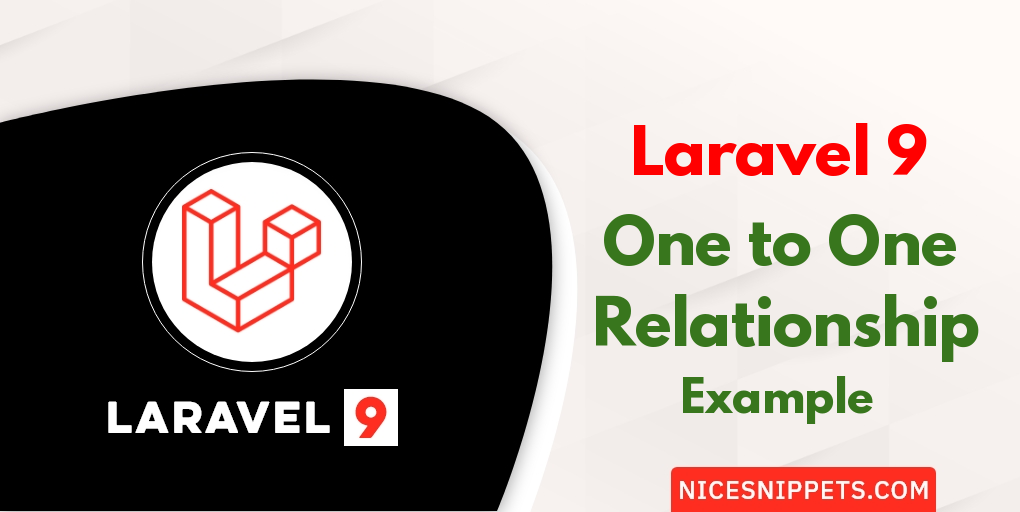10-Apr-2023
.
Admin

Hi friends,
Today, I am exaplian laravel 9 one to one relationship tutorial with example. One to One model relationship is very simple and basic. When one table refers to single row in another table that is called a one-to-one relationship. This tutorial will see how the One To One Relationship in Laravel 9 is working with an example.
Eloquent relationships are defined as methods on your Eloquent model classes. Inside this article we will see the concept of laravel 9 One to One Eloquent relationship as well as we will implement inverse of one to one relationship i.e belongs to.
So let's start following example:
Download Laravel
Let us begin the tutorial by installing a new laravel application. if you have already created the project, then skip following step.
composer create-project laravel/laravel example-app
Add Migrations
Now we have to create migration of "users" and "phones" table. we will also add foreign key with users table. so let's create like as below:
database/migrations/2014_10_12_000000_create_Users_table.php
<?php
use Illuminate\Database\Migrations\Migration;
use Illuminate\Database\Schema\Blueprint;
use Illuminate\Support\Facades\Schema;
return new class extends Migration
{
/**
* Run the migrations.
*
* @return void
*/
public function up()
{
Schema::create('users', function (Blueprint $table) {
$table->id();
$table->string('name');
$table->string('email')->unique();
$table->timestamp('email_verified_at')->nullable();
$table->string('password');
$table->rememberToken();
$table->timestamps();
});
}
/**
* Reverse the migrations.
*
* @return void
*/
public function down()
{
Schema::dropIfExists('users');
}
};
phones table migration:
php artisan make:migration create_phones_table
database/migrations/2014_10_12_000000_create_phones_table.php
<?php
use Illuminate\Database\Migrations\Migration;
use Illuminate\Database\Schema\Blueprint;
use Illuminate\Support\Facades\Schema;
return new class extends Migration
{
/**
* Run the migrations.
*
* @return void
*/
public function up()
{
Schema::create('phones', function (Blueprint $table) {
$table->id();
$table->foreignId('user_id')->constrained('users');
$table->string('phone');
$table->timestamps();
});
}
/**
* Reverse the migrations.
*
* @return void
*/
public function down()
{
Schema::dropIfExists('phones');
}
};
Add Models:
Here, we will create User and Phone table model. we will also use "hasOne()" and "belongsTo()" for relationship of both model.
app/Models/User.php
<?php
namespace App\Models;
use Illuminate\Contracts\Auth\MustVerifyEmail;
use Illuminate\Database\Eloquent\Factories\HasFactory;
use Illuminate\Foundation\Auth\User as Authenticatable;
use Illuminate\Notifications\Notifiable;
use Laravel\Sanctum\HasApiTokens;
class User extends Authenticatable
{
use HasApiTokens, HasFactory, Notifiable;
/**
* The attributes that are mass assignable.
*
* @var array
*/
protected $fillable = [
'name',
'email',
'password',
];
/**
* The attributes that should be hidden for serialization.
*
* @var array
*/
protected $hidden = [
'password',
'remember_token',
];
/**
* The attributes that should be cast.
*
* @var array
*/
protected $casts = [
'email_verified_at' => 'datetime',
];
/**
* Get the phone associated with the user.
*
* Syntax: return $this->hasOne(Phone::class, 'foreign_key', 'local_key');
*
* Example: return $this->hasOne(Phone::class, 'user_id', 'id');
*/
public function phone()
{
return $this->hasOne(Phone::class);
}
}
php artisan make:model Phone
app/Models/Phone.php
<?php
namespace App\Models;
use Illuminate\Database\Eloquent\Factories\HasFactory;
use Illuminate\Database\Eloquent\Model;
class Phone extends Model
{
use HasFactory;
/**
* Get the user that owns the phone.
*
* Syntax: return $this->belongsTo(Phone::class, 'foreign_key', 'owner_key');
*
* Example: return $this->belongsTo(Phone::class, 'user_id', 'id');
*/
public function user()
{
return $this->belongsTo(User::class);
}
}
Retrieve Records:
app/Http/Controllers/UserController.php
<?php
namespace App\Http\Controllers;
use Illuminate\Http\Request;
use App\Models\User;
class UserController extends Controller
{
/**
* Write code on Method
*
* @return response()
*/
public function index(Request $request)
{
$phone = User::find(1)->phone;
dd($phone);
}
}
app/Http/Controllers/UserController.php
<?php
namespace App\Http\Controllers;
use Illuminate\Http\Request;
use App\Models\Phone;
class UserController extends Controller
{
/**
* Write code on Method
*
* @return response()
*/
public function index(Request $request)
{
$user = Phone::find(1)->user;
dd($user);
}
}
Add Records:
app/Http/Controllers/UserController.php
<?php
namespace App\Http\Controllers;
use Illuminate\Http\Request;
use App\Models\User;
use App\Models\Phone;
class UserController extends Controller
{
/**
* Write code on Method
*
* @return response()
*/
public function index(Request $request)
{
$user = User::find(1);
$phone = new Phone;
$phone->phone = '9429343852';
$user->phone()->save($phone);
}
}
app/Http/Controllers/UserController.php
<?php
namespace App\Http\Controllers;
use Illuminate\Http\Request;
use App\Models\User;
use App\Models\Phone;
class UserController extends Controller
{
/**
* Write code on Method
*
* @return response()
*/
public function index(Request $request)
{
$phone = Phone::find(1);
$user = User::find(10);
$phone->user()->associate($user)->save();
}
}
It will help you...
#Laravel 9